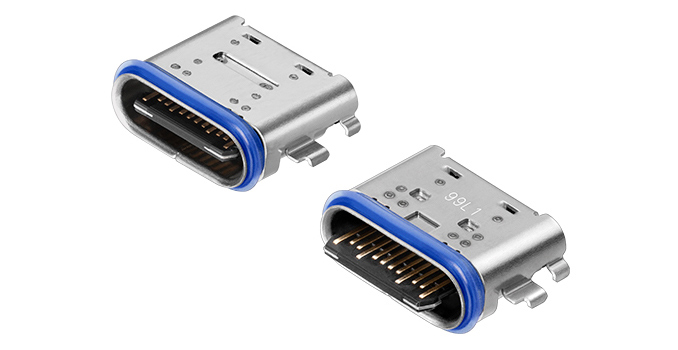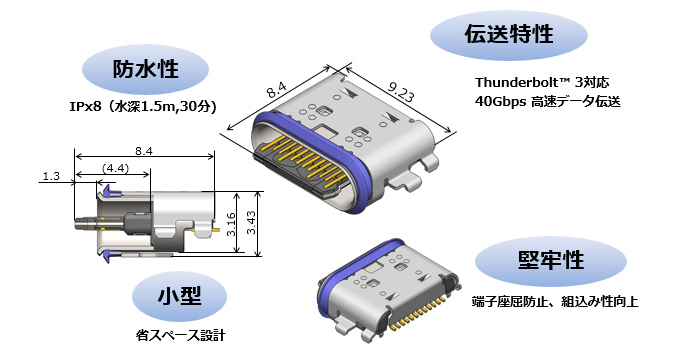MinibeaMitsumi Launches IP68-Rated USB-C/Thunderbolt 3 Connector
by Anton Shilov on February 10, 2020 3:00 PM EST- Posted in
- Peripherals
- Thunderbolt 3
- USB-C

MinibeaMitsumi has unveiled the industry’s first dustproof and waterproof USB Type-C connector that is certified for Thunderbolt 3 speeds. The connector can be used for a variety of applications that require high bandwidth and high reliability in harsh environments.
The MinibeaMitsumi CAM-L41-series connector is is formally IP68-certified, and uses a proprietary waterproof structure that allows it to operate for 30 minutes while submerged in up to 1.5 meters of water. The connector has been certified for Thunderbolt 3 technology and all of its features, including a 40 Gbps data transfer rate, and power delivery. The company expects to eventually gain certification for the USB4 specification too.
There are numerous applications nowadays, including those in harsh environments, that use USB-C connectors. Examples include industrial, rugged PCs, wearables, medical devices, automotive infotainment, various home appliances, and outdoor displays, just to name a few. A number of companies have released IP68 and even IP69K USB-C connectors for such applications, but all of them are only certified for 5 Gbps or 10 Gbps operation. By contrast, the CAM-L41 was certified for 40 Gbps data rate and will appeal to applications that require high bandwidth in severe environments.
The new connectors are now available from MinibeaMitsumi.
Related Reading:
- Kensington’s SD5500T TB3/USB-C Hybrid Docking Station: Titan Ridge Inside
- CRU ioSafe Solo Hawk Rugged SSD Review
- USB4 Specification Announced: Adopting Thunderbolt 3 Protocol for 40 Gbps USB
- Cosemi Launches USB 3.1 Gen 2 Hybrid Active Optical Cable: Up to 50 Meters of USB
- Innodisk Unveils Fire Shield SSD: Withstands 800°C Temperature & Direct Flames
Source: MinibeaMitsumi (via PC Watch)











21 Comments
View All Comments
eek2121 - Monday, February 10, 2020 - link
My phone is supposedly rated ip68, does not have a cover on either the headphone jack or USB type C port. It has been in the swimming pool and washing machine, yet hasn't had an issue. It is 3 years old. Am I missing something here?eek2121 - Monday, February 10, 2020 - link
Nevermind, missed that last paragraph.Smell This - Tuesday, February 11, 2020 - link
That brings up a very interesting point --- just because the ''connector" is rated does not necessarily mean that the device to which it is connected is qualified and certified in a specific use or application.Example: The phone you dunked in the washer, for standards X-Y, works for submersion and shock resistance, but not corrosion and chemicals (the soap and chlorine bleach) ...
Samus - Tuesday, February 11, 2020 - link
The general assumption of any device being sold with a certification is all components of the device inherit the certification. To say otherwise would be falsely advertising the device.dryvelectronics - Monday, February 10, 2020 - link
Mobile devices with USB4 specs may take a huge hit to tablet and laptop sales as long as the manufacturer enables all of its capabilities. If I had a full computer in my hand, with a type C hub, I wouldn't need the bulkier devices anymore.HStewart - Monday, February 10, 2020 - link
I remember the days before USB with Parallel and Serial Ports and some as the long as some USB hubs. This is great for tablets and laptops and of course mobile phones.. But it appears that one day desktops will grow up and use more of the ports. Even resent motherboards like ASRock motherboard advertise on this page have PS/2 ports which were in 1987 over 40 years ago.Valantar - Tuesday, February 11, 2020 - link
The reason for PS/2 ports still being around is that there is a small but vocal subset of enthusiasts that insist on using them - mainly as they claim the interrupt-based signalling is faster or more responsive than the polling-based signalling of USB. This is largely nonsense, but they're loud enough to matter. I've heard that a lot of sysadmins and service technicians also prefer PS/2 for its reliability (though I struggle to see how this group would do without hotplug support...).sonny73n - Tuesday, February 11, 2020 - link
Nonsense. Some BIOS only works with PS/2 keyboards.You should google “PS/2 vs USB” and read some in-depth articles about it. You can save us a lot time explaining to you why some of us, especially those in IT field, prefers PS/2 over USB.
Samus - Tuesday, February 11, 2020 - link
As an IT admin I could give two shits about polling speed, it's about reliability.JoeyJoJo123 - Tuesday, February 11, 2020 - link
Also, NKRO is easier to achieve via PS/2, rather than the hacky way modern USB NKRO keyboards do it, by appearing as multiple USB devices (sometimes up to 10 different devices) for the same keyboard, just so that the matrix detecting keypresses in different areas of the keyboard have their own USB data stream which doesn't conflict with keypresses elsewhere on the keyboard. Since PS/2 is interrupt based, when and if you hold a key down, system interrupt happens and it processes that input immediately, and other keys being pressed down doesn't prevent the new key that's also being pressed from being processed.